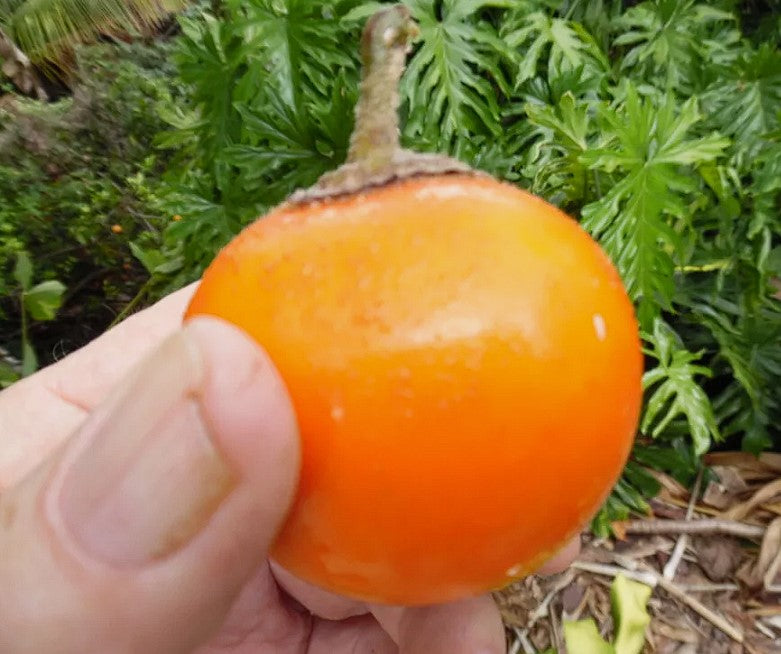speedy-seeds.co.uk
Naranjilla | (Solanum Quitoense) | 25+ seeds
Couldn't load pickup availability
Please find for sale 25+ fresh seeds for Naranjilla (Solanum Quitoense) aka Lulo “The golden fruit of the Andes,”. In late spring I also sell plants that I have grown from these seeds - if you want to save yourself some time, find these on my other items for sale.
PLEASE NOTE: All orders received before 8pm (Mon-Fri) will be dispatched same day
SAVE PACKAGING MATERIALS - SEE OTHER INTERESTING & UNUSUAL SEEDS & PLA
INSTRUCTIONS - TO SAVE PAPER I NO LONGER SEND OUT WRITTEN INSTRUCTIONS TO CUSTOMERS. INSTRUCTIONS ARE BELOW SO PLEASE BOOKMARK THIS PAGE. FEEL FREE TO MESSAGE ME WITH ANY GROWING QUESTIONS.
Description
Naranjilla plants are herbaceous shrubs with a spreading habit that are commonly found throughout Central and South America. Wild growing naranjilla plants are spiny, while cultivated varieties are spineless and both types having thick stems which become woody as the plant matures. The foliage of the naranjilla consist of 2-foot long, heart-shaped leaves that are soft and woolly; when young, the leaves are coated with brilliant purple hairs. Fragrant flower clusters are borne from the naranjilla plants with five white upper petals morphing into purple haired beneath. The resulting fruit is covered with brown hairs that are easily rubbed off to reveal the bright orange exterior. Inside the naranjilla fruit, the green to yellow juicy sections are separated by membranous walls. The fruit tastes like a delicious combination of pineapple and lemon and is peppered with edible seeds.
Naranjilla fruit is juiced and drunk as a beverage (lulo), and the fruit is also used in various sherbets, ice creams, native specialties even wine. The fruit may be eaten raw by rubbing off the hairs and then halving and squeezing the juicy flesh into ones mouth, discarding the shell.
Growing Conditions
Naranjilla can be grown in the UK as a container plant - quite happy in gardens during spring and summer but brought indoors during winter. Although it is a subtropical species, the Naranjilla cannot tolerate temperatures over 29C and flourishes in climates with temps between 17-19C and high humidity. Intolerant of full sun exposure, naranjilla growing conditions should additionally be in semi-shade. Naranjilla plants are also often grown as full time conservatory plants.
Germination Guide
- Sow indoors in late winter / early spring
- Prepare a seed tray filled with moist (but not wet) seed compost, lightly firmed down
- Ideally a well draining mix of 50% sieved compost and 50% vermiculite or horticultural sand
- Sow seeds over surface of the seed compost, several cm apart
- Very gently pat the seeds down so they are in contact with the compost
- Cover with a fine layer of sieved compost
- Trays can partially covered with plastic/clingfilm etc to increase humidity but this increases the risk of rot so I prefer to leave uncovered and water from the bottom - see below
- Keep surface moist but not wet - best to water from the bottom by having seeds tray inside a waterproof container.
- Keep at 17-25 degrees during ideally on a heat at if you have one or on window sill over a radiator
- Seedlings should appear in 4-6 weeks. Patience required.
- Thin seedlings and pot on as required.
Materials
Materials
Shipping & Returns
Shipping & Returns
Dimensions
Dimensions
Care Instructions
Care Instructions

Image with text
Pair text with an image to focus on your chosen product, collection, or blog post. Add details on availability, style, or even provide a review.
-
Free Shipping
Pair text with an image to focus on your chosen product, collection, or blog post. Add details on availability, style, or even provide a review.
-
Hassle-Free Exchanges
Pair text with an image to focus on your chosen product, collection, or blog post. Add details on availability, style, or even provide a review.

